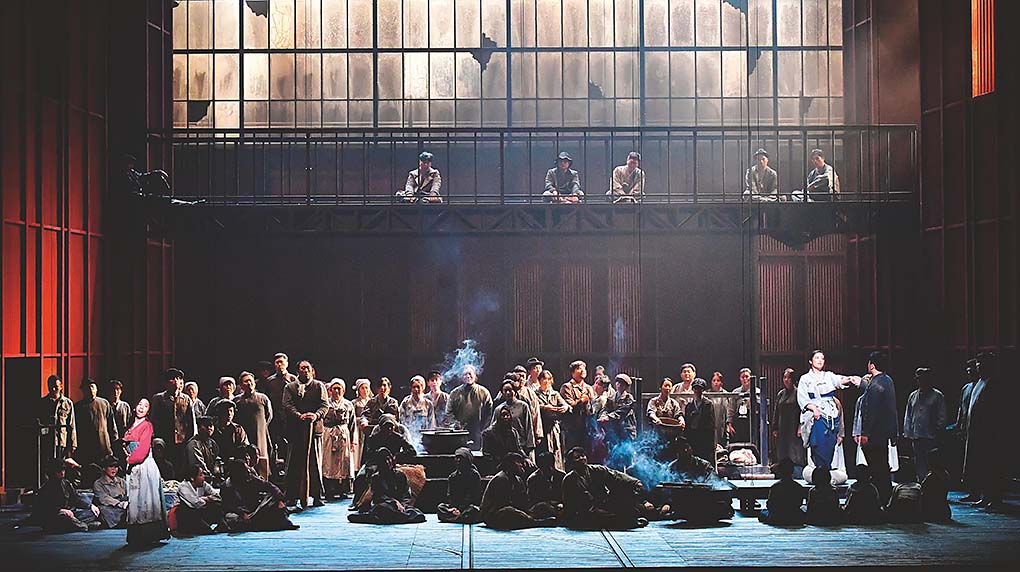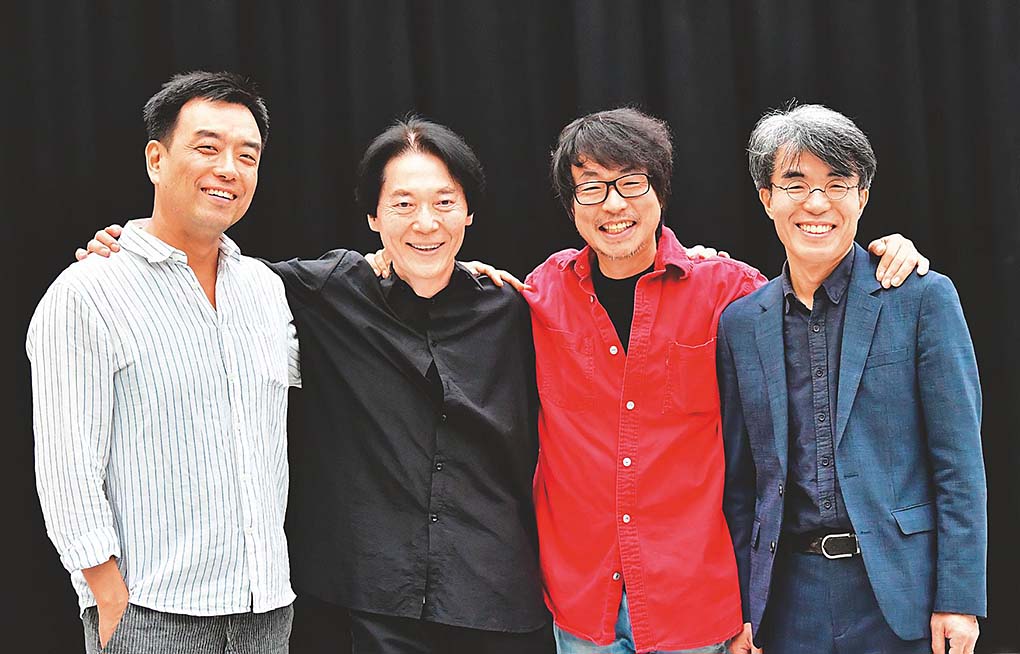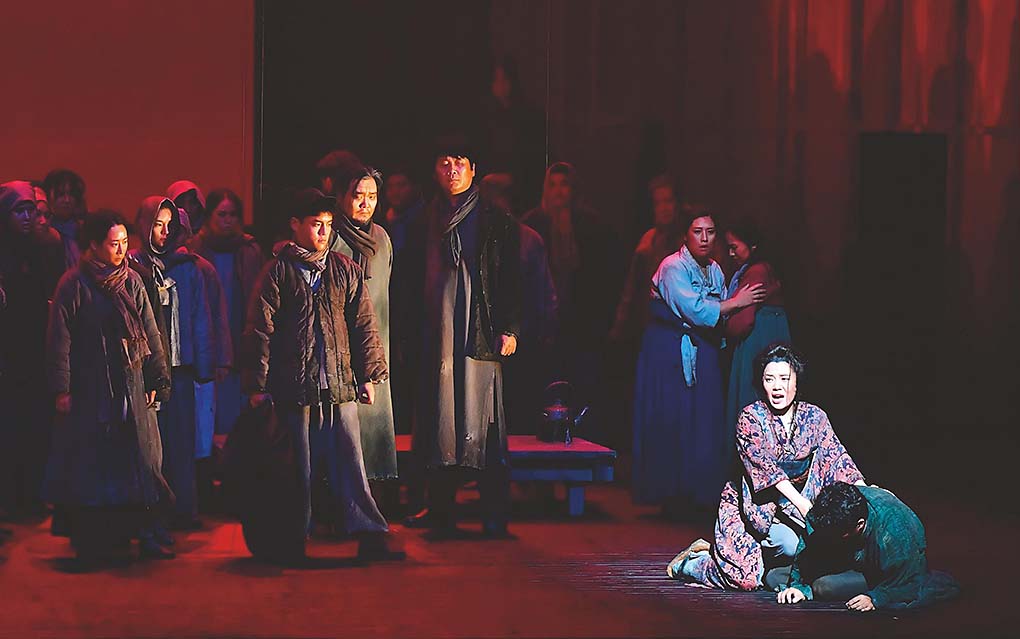The opera “1945” was staged in 2019 by the Korea National Opera to mark the 100th anniversary of the March First Independence Movement and the subsequent establishment of Korea’s provisional government in Shanghai. Its musical achievements aside, the show seemed especially relevant amid the ongoing tensions between Seoul and Tokyo.

The opera “1945,” staged by the Korea National Opera from late September to early October 2019, is set in the gloomiest of times, but the producer adopted elements of humor and satire to deliver a sense of warmth to the audience. In this scene, right after World War II, the women at a temporary shelter for refugees in Manchuria make rice cake. © Korea National Opera
The sensation of the autumn 2019 opera season was the Korea National Opera’s “1945,” which ran from late September to early October at the Seoul Arts Center and the Daegu Opera House. This beautifully mounted show was adapted from a play of the same name that had been presented two years earlier by the National Theater Company of Korea. The production was first proposed by composer Choe Uzong, who was deeply moved by the original play by Pai Sam-shik.

“1945” created the biggest buzz in Korea’s performing arts scene during the fall 2019 season. The key crew members are (from left): composer Choe Uzong, conductor Chung Chi-yong, producer Koh Sun-woong and playwright Pai Sam-shik.
Manchuria in 1945
The opera is set in Manchuria in the eponymous year, right after the end of World War II and Korea’s liberation from Japan. It depicts events taking place at a temporary shelter for displaced Koreans waiting for their chance to return home. The lead characters are Bunee, who is Korean, and Mizuko, who is Japanese; both women were forced into sexual slavery for the Japanese military. After Korea is freed from Japanese colonial rule, Bunee tells Mizuko, “Let’s go our separate ways.” But when she realizes she cannot just turn her back on the pregnant Mizuko, she tries instead to fool others into thinking that Mizuko is her mute sister and looks for a way to bring her to Korea. As the story of these two women unfolds, the audience is led to reconsider the black-and-white logic of nationalism that often pits Korea and Japan against each other and to think about the value of tolerance.
The opera resonated deeply with the audience, not just because of its focus on human nature and the tragedy of life. The script, written by Pai himself, added depth to the story. Dramatic engagement was then further intensified by Choe, who recomposed diverse styles of popular music of the 1940s from a range of different backgrounds. Producer Koh Sun-woong, well known for his ingenious interpretation and eye for stage execution, infused sad scenes with wit and satire instead of making them melodramatic, thereby rousing greater empathy. And conductor Chung Chi-yong, noted for his delicate yet powerful orchestration, led a fine performance.

A Korean woman pleads her case before the others at the temporary shelter who have condemned her for marrying a Japanese man. The opera challenges the black-and-white logic of nationalism, advocating tolerance which is all about understanding and embracing the pain of others.
Music Elevates Language
Of all the aspects of the opera, the lyrics stood out most. The recitativo style, which focuses more on the delivery of the lyrics themselves than on the melody, was reminiscent of 20th century operas such as Alban Berg’s “Wozzeck” and “Lulu.” Subtitles were provided to help convey the lyrics more precisely.
Choe began writing the score with a question in mind: “What kinds of songs were sung at the time and how did they come to be known?” He defined the 1930s and 1940s as historically fraught but rich in musical legacy. Before composing, he searched through the diverse genres of music that were popular at the time, including nursery rhymes, traditional folk songs, trot songs, Western-style songs (changga) and military cadences. His efforts resulted in an opera characterized by a fascinating mixture of musical styles, ranging from the nursery rhyme “Mother, Sister” and popular trot song “Tearful Manchurian Train” to jazz, changga and military songs.
However, the score is far from a simple pastiche. Choe listened to the songs he chose over and over on a gramophone, reprocessing all but a few to make them fit the opera. He did not take a theoretical approach, studying aspects such as scale, pitch structure or form. Instead, he familiarized himself with the songs until he was able to make the melodies sound fresh in a new context. As a result, the “musical fiction” running throughout the opera served as a mechanism that allowed the audience to sympathize more fully with the sentiments expressed on stage, leading to a deeper engagement with the drama.
Choe is surely not the first to pioneer this method. Bach, Mozart and Beethoven did not hesitate to make appropriations of the commonly hummed tunes of their era. Ultimately, it has been reaffirmed that directly citing music contemporaneous to the action of the opera can help heighten the sense of reality.
Choe had already stood by the notion that music can serve language through his work on the highly acclaimed opera “As the Moon Arrives on the Water,” which premiered in 2014. For “1945,” he enlarged the scale of his endeavor to elevate language through music by means of a much newer, larger vessel, providing a glimpse into his world growing deeper and wider.
Music Induces Immersion
By skillfully balancing painful history with humor and satire, “1945” created both tension and relaxation for the audience. The song “Tearful Manchurian Train,” sung by the whole cast as they form a human train, narrowed the distance between spectators and the action on stage, inviting applause quite naturally. Meanwhile, the Japanese song performed by young children confused about their national affiliation because they were born during Japanese rule and the piece sung by Mizuko were as clear and pure as a full moon in an autumn night sky.
The commotion created by a character’s gift of dried pollack and the scene of women making rice cake together conveyed images of abundance rather than poverty. It implied that however dire their situation became, people’s dreams could not be taken away. The opera’s climax came with Mizuko’s identity being discovered, with deftly alternating scenes of conflict and catharsis working to create a natural dramatic composition. Ultimately, the fine script by Pai, mellow music by Choe and excellent production by Koh made the whole show flow smoothly.
In Act 4, the curtain fell with people aboard the train on one side and Bunee and Mizuko, unable to board, on the other — a symbolic moment portending the upcoming division of Korea into north and south. Interestingly, François Couperin’s music was employed here; it effectively prevented the act from ever becoming banal. In the epilogue that followed, Bunee and Mizuko sang a beautiful duet against a snowy background, creating a cinematic ambience likely to remain in the hearts of the audience for a long time.
An opera cannot succeed without good songs; this is all the more true for an adaptation of a stage play. Soprano Lee Myung-joo played Bunee with a vocal finesse she had previously displayed on large stages, including a performance of Beethoven’s “Symphony No. 9” with the Seoul Philharmonic Orchestra. Soprano Kim Soon-young, a proven musical actor, aptly portrayed Mizuko.
The train arrives to take the residents of the temporary shelter back to Korea, but Bunee and Mizuko fail to get on board. Bunee chooses to stand by her Japanese colleague, Mizuko, who has shared her suffering, instead of returning home with her compatriots.
The opera’s climax came with Mizuko’s identity being discovered,
with deftly alternating scenes of conflict
and catharsis working to create a natural dramatic composition.
Commendable Cast
Other performers who stood out included tenor Lee Won-jong as Oh In-ho, who helps Bunee out of his special feelings for her, and mezzo soprano Kim Hyang-eun as Park Seop-seop, a very tough and tenacious yet likeable character. The Korean Symphony Orchestra, under the baton of Chung Chi-yong, maintained a subtle balance between tonal and atonal music, effectively supporting the rich lyricism of the Korean words being sung.
The second half of 2019 has witnessed aggravation in Korean-Japanese relations due to differences in how each nation perceives history. Apart from its notable operatic achievements, “1945” was significant for its two lead characters who, with shared wartime trauma, struggle to overcome the conflict between their nations with the warmth in their hearts.